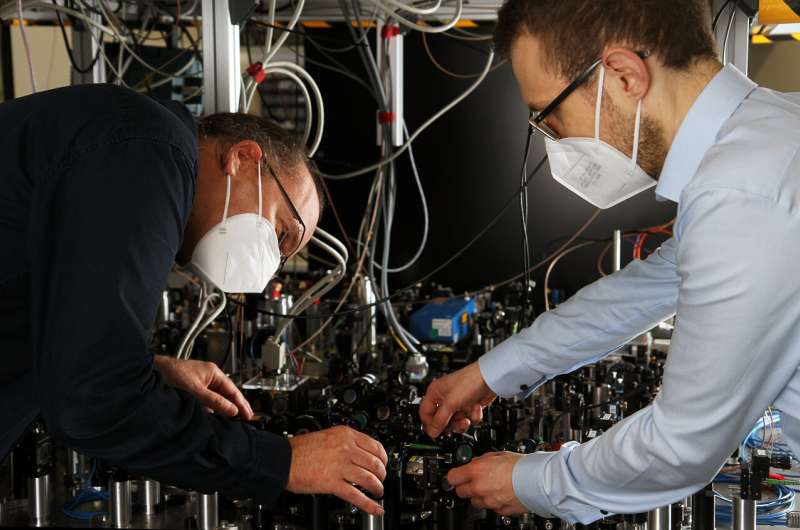Physicists identify energy states of individual atoms following a collision

Physicists at Technische Universität Kaiserslautern in the team of Professor Dr. Herwig Ott have succeeded for the first time in directly observing collisions between highly excited atoms, so-called Rydberg atoms, and atoms in the ground state. Particularly interesting is that they can precisely identify the energy states of the individual atoms, which was impossible until now. The researchers have developed a custom microscope for this purpose, with which they were able to directly measure the momenta of the atoms. The processes observed are important for understanding interstellar plasma and ultracold plasmas generated in the laboratory. The study was published in the renowned journal Nature Communications.
For their experiment, the physicists used a cloud of rubidium atoms that was cooled down in an ultra-high vacuum to about 100 microkelvin—0.0001 degrees above absolute zero. Subsequently, they excited some of these atoms into a so-called Rydberg state using lasers. "In this process, the outermost electron in each case is brought into far-away orbits around the atomic body," explains Professor Herwig Ott, who researches ultracold quantum gases and quantum atom optics at TU Kaiserslautern. "The orbital radius of the electron can be more than one micrometer, making the electron cloud larger than a small bacterium." Such highly excited atoms are also formed in interstellar space and are chemically extremely reactive.
If a Rydberg atom and an atom in the ground state clash, a so-called inelastic collision occurs. "This is when the atom in the ground state dives deep into the orbit of the Rydberg electron," explains Professor Ott. What follows is that the molecular dynamics of the two atoms is highly complex and leads to their separation, whereby the orbit of the electron has changed.
"In this change of state, both the principal quantum number and the angular momentum quantum number of the electron can change," says Philipp Geppert, who is first author of the study. Geppert explains further that based on the distribution of these final states, it is possible to gain new insights into atomic collision processes where both large and small internuclear distances are important.
In this final state, the Rydberg electron returns to an orbit that is closer to the atomic nucleus. In the process, energy is released, which is transferred in the form of kinetic energy to both atoms involved. Due to the conservation of momentum, the atoms move apart in opposite directions.
The scientists have developed a momentum microscope especially for this experiment to observe such motion. The basic principle is quite simple: The neutral atoms are ionized with a laser pulse and directed towards a position-sensitive detector by means of a weak electric field. The point of impact depends on the initial velocity of the atoms and thus indicates their momentum. The microscope is capable of resolving the smallest velocity differences thereby making it possible to precisely identify the final states of the individual atoms.
This knowledge helps to understand fundamental atomic processes in plasma. Plasma is a mixture of different particles such as electrons, ions, atoms, and molecules. In research, plasma plays an important role, for example, to study the interaction between particles more closely. Since it also occurs in space, results from the laboratory can be relevant for astrophysics, for example to better understand which chemical and physical processes take place in interstellar space.
Research on this study took place within the priority program "Giant Interactions in Rydberg Systems," which is funded by the German Research Foundation. This research was carried out in the OPTIMAS profile area (Landesforschungszentrum für Optik und Materialwissenschaften—State Research Centre for Optics and Materials Sciences), which has been funded as part of the state's research initiative since 2008.
More information: Philipp Geppert et al, Diffusive-like redistribution in state-changing collisions between Rydberg atoms and ground state atoms, Nature Communications (2021). DOI: 10.1038/s41467-021-24146-0
Journal information: Nature Communications
Provided by Technische Universität Kaiserslautern



















